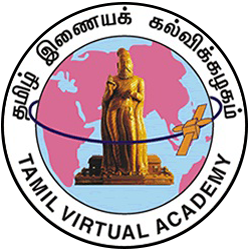Primary tabs
D03136 Principles of Poetry - Kaudam
This lesson explains the principles of poetry or ‘Cheyyul Neri’ expounded in the ‘Kauda Neri’. It illustrates the 10 salient principles of ‘Kauda Neri’ and traces the similarities and differences between ‘Vaidaruppa Neri’ and ‘Kaudam’.
‘Serivu’, ‘thelivu’, ‘samanilai’, ‘inbam’, ‘ozhugisai’, ‘udaaram’, ‘uythalil porunmai’, ‘kantham’, ‘vali’ and ‘samathi’ are the 10 features or principles of ‘Kauda Neri’. The Kauda Neri refutes many of the principles propounded in the Vaidarupa Neri. There are no specific verses pertaining to Kauda Neri in ‘Dandialangaaram’. It is only through the examples cited by commentators that we understand the basic tenets of Kauda Neri and how they differ from the Vaidaruppa Neri.
While Vaidaruppa Neri defines ‘serivu’ as terse construction of a verse achieved through the rhythmic arrangement of the 6 hard consonants, i.e., (vallinam) and long consonant-vowel, Gaudam defines ‘serivu’ as ‘negizhchi’ or a gentle flow of the verse obtained by mixture of the ‘idaiyina mei’ i.e., (the 6 medial consonants in the Tamil tripartite system) and the ‘uyirmei’ i.e., the consonant-vowel.
The Vaidaruppa Neri defines ‘Thelivu’ as avoiding ‘thirisorkal’ that may cause ambiguity in a verse or in other words, ‘Thelivu’ is clarity of meaning. Kaudam, on the contrary, does not stress on clarity of meaning but defines ‘Thelivu’ as word play or the use of striking words in order to convey meaning.
Vaidaruppam defines ‘Samanilai’ as the harmonious use of the ‘vallinam’, ‘mellinam’ and ‘idaiyinam’ sounds in a verse. As opposed to this, Gaudam decrees that ‘Samanilai’ is attained in a verse when ‘vallinam’ or the 6 hard consonant sounds are used more often than ‘idaiyinam’ i.e., (the 6 medial consonants) and ‘mellinam’ i.e., (the 6 nasal consonants). Both the Vaidaruppa Neri and Gauda Neri define ‘porul inbam’ in the same way. However, they differ in their perception of ‘sol inbam’. According to Kaudam’ ‘Sol inbam’ is the use of alliteration (‘monai’) in the first 5 ‘seerkal’ or (metrical foot) of an ‘aru seer virutham’ i.e., a kind of meter in Tamil prosody. Vaidaruppam and Gaudam are similar in their conception of the principles of ‘ozhugisai’ and ‘udaaram’.
When the words in the verse are self-explanatory, that is, when it is not necessary to add words to a verse, in order to understand its meaning, the verse is said to possess ‘uythalil porunmai’ according to both Vaidaruppam and Gaudam.
In Vaidaruppam, ‘Kantham’ is the technique of exalting something without exaggerating. While the poet may use his imagination to describe something in lofty terms, he also remains within the bounds of realism. As against this, Gaudam defines ‘Kantham’ as the use of hyperbole or exaggerated descriptions. Incorporating a considerable number of ‘thogai sol’ or ellipsis in a verse is called ‘Vali’ in Vaidaruppa neri. Gauda Neri defines ‘Vali’ as the use of ‘thogai sorkal’ or ellipses in large numbers. Both Vaidaruppam and Gaudam agree on the principle of ‘samaathi’.


